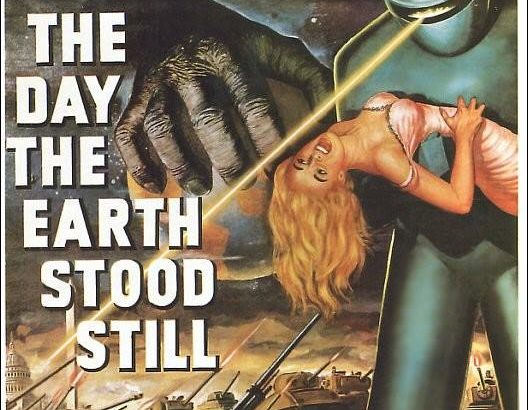
CINE FORO SOBRE CINE AMERICANO – ASPECTOS A CONSIDERAR DURANTE LA VISUALIZACIÓN DE LA PELÍCULA PARA EL POSTERIOR DEBATE: ULTIMATUM A LA TIERRA
Uno de los hitos del cine americano de ciencia-ficción de los años 50, pues reúne la mayoría de sus constantes: llegada de extraterrestres, presencia de inteligencias superiores o robots, problema grave que puede ser mundial, paranoia social como reflejo de la guerra fría, violento sistema de defensa humano (ejército, policía) ante lo desconocido, representación de la ciencia…
Todo lo anterior sin embargo se matiza con dos rasgos sorprendentes. Por un lado, un tono en línea con el Thriller que producía entonces la misma productora, 20Th Century Fox (ambientación realista, blanco y negro contrastado, persecuciones), con directores como Elia Kazan, Joseph L. Mankiewicz o Henry Hathaway. Por otra parte, nobles y bellos matices melodramáticos, en el reflejo de la inserción del extraterrestre protagonista en una familia rota: gracias a él, la viuda protagonista advertirá que su pretendiente no es más que un ser mezquino y el hijo puede gozar de una especie de segundo padre, noble y altruista; la desaparición final del extraterrestre dejará a esta mujer y este niño tristes y desesperanzados. Todo ello dentro de una gran sobriedad, conteniendo la emoción; en este sentido, son magistrales dos escenas de la pareja estelar, la que transcurre en el ascensor en penumbras, sobre todo, y la curación de Klaatu dentro del platillo volante, cuando ella escucha que será momentánea y no sabe cuánto durará.
La película introduce también un toque mesiánico, pero de forma fina y sutil, sin los excesos, ideológicos y ternuristas, en que incurría deliberadamente Spielberg tiempo después en ET (1982). Del mismo modo, brinda un mensaje antimilitarista y pacifista que sorprende dentro del belicoso contexto histórico y cinematográfico, no menos ingenuo y simple menos firme ni valiente en la época: el extraterrestre no deja de ser atacado y hostigado, cuando sólo busca la concordia.
La estética puramente fantacientífica también es de hermosa sobriedad: el diseño de la nave, del traje extraterrestre, del robot… son de una justeza estilizadísima, que contrastan bellamente con el tono ominoso y suntuoso de la música del gran Bernard Herrmann, músico recurrente de Hitchcock durante muchos años, que debutó en el cine con Ciudadano Kane.
Es una de las mejores películas del director Robert Wise, que empezó como montador del mismísimo Orson Welles en Ciudadano Kane y El cuarto mandamiento, y a quien se deben otros clásicos, tan diferentes como ¡Quiero vivir! (1958), West Side Story (1961), The Haunting (1963) y Sonrisas y lágrimas (1965). Su siguiente película de ciencia-ficción fue la primera adaptación al cine de la serie Star Trek, en 1980.
En el 2008 se hizo un remake con el mismo título, dirigido por Scott Derrickson y protagonizado por Keanu Reeves.



